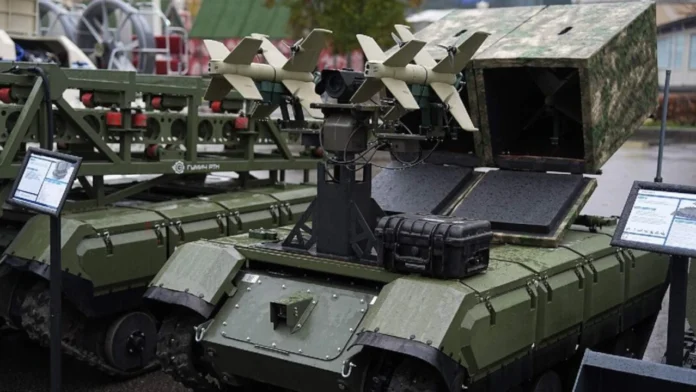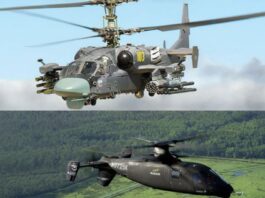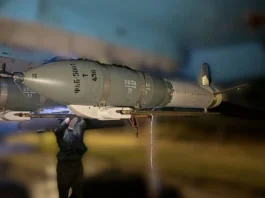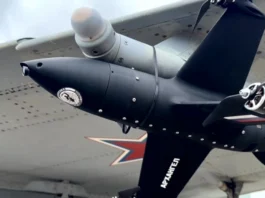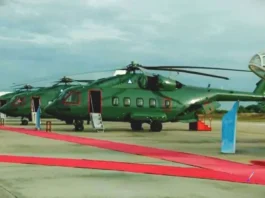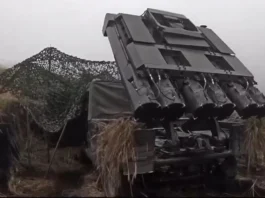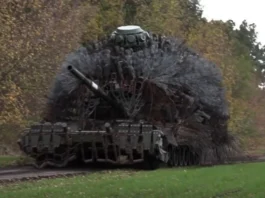Russia has unveiled a new robotic air defense system known as Impulse-PVO in response to the growing threat presented by small unmanned aerial vehicles (UAVs), notably during the current crisis in Ukraine. Impulse-PVO, which Gumich RTK unveiled at a Moscow expo, is a compact, autonomous short-range complex distinguished by the deployment of eight Elka interceptor drones. This new approach marks a major change in how Russia defends its airspace, showing that the country is focusing more on using technology, quick reactions, and direct hits to deal with enemy drones.
The Technical Profile of Impulse-PVO
Impulse-PVO is based on a tracked chassis that is geared for mobility across diverse terrain for frontline use in dynamically evolving battle zones. Its distinguishing feature is the integrated launching system, which transports and launches eight Elka interceptor drones. These drones, weighing only 1.35 kilograms each, are designed for speed and agility, with a reported top speed of 200 kilometers per hour, promising swift interception of hostile UAVs operating at low altitudes.
Elka drones work by colliding with target UAVs and using their kinetic energy to eliminate the aerial threat. This kind of interception is especially effective against small drones, which can elude standard missile systems due to their small size, irregular flight paths, and low radar signature. Russian media and defense experts emphasize that the Elka drone’s lightweight design and rapid acceleration are ideal for these kinetic countermeasures, making Impulse-PVO an effective solution for emergent “drone swarms” and solitary reconnaissance UAVs that frequently probe Russian positions or strategic assets.
Operating Modes and Guidance
One of Impulse-PVO’s distinguishing features is its frequency spectrum operation, which spans 700 MHz to 6200 MHz. This wide frequency range is important for maintaining guidance, control, and targeting in challenging electromagnetic environments where enemy electronic warfare and jamming are common. The optoelectronic guiding module connected to the launcher helps find and hit targets more reliably, making the system effective even in low-light or electronic interference situations.
Elka drones can be launched by hand for immediate response or from specialized launchers that hold two drones and are equipped with precision targeting modules. Such flexibility allows Russian forces to quickly respond to drone threats with targeted firepower or to use the system in more complex defense setups around key infrastructure.
Automation and Doctrine Evolution
Impulse-PVO is designed for remote control and autonomous operation, reflecting Russia’s rising strategic trend of automating close-range air defense. This move tackles the operational difficulty of protecting scattered assets and moving fire groups, especially now that the Ukrainian conflict has proved the destructive effectiveness of drone-borne weapons and monitoring.
Remote operation allows operators to manage a single Impulse-PVO unit or a networked group of units from safe positions, decreasing personnel risk while maintaining defensive coverage. The Russian defense sector is very interested in adding robots and AI systems to their current air defense networks, and the presentation of Impulse-PVO is seen as a move towards a larger system that can support mobile fire teams and flexible defense at the front lines.
Current Deployment and Strategic Implications
While the entire operational deployment of Impulse-PVO has yet to be confirmed, Russian sources say Elka drones are already being used on the front lines against Ukrainian UAVs. These interceptors are used both manually and with launcher assistance, and they are credited with increasing Russia’s ability to respond to swift drone intrusions without relying entirely on small weapons or heavyweight AA units.
The recent drone assaults on Moscow highlight the seriousness of these developments. In response to a large drone raid, Russian security services created mobile fire groups around the Kremlin late on October 27. Photographs circulating in Russian media show pickup trucks equipped with Pecheneg machine guns, which are used to visually detect and intercept approaching drones. Military analysts assert that these ad hoc units lacked dedicated night vision or electronic detection systems, a gap that robotics such as Impulse-PVO aim to address.
Comparative Edge and Limitations
The Impulse-PVO and its Elka drone interceptors are a tactical breakthrough designed to meet the demands of current asymmetric warfare. Unlike Western options, such as the deployment of directed-energy weapons or advanced radar-guided missiles, the Russian system favors cost-effective, nimble kinetic interceptors with great mobility. It is clear that it can easily work with bigger air defense systems, offering multiple levels of protection against various types of drones, from modified commercial ones to specialized attack UAVs.
However, limits exist. Elka interceptors rely on closeness and direct collision; their effectiveness may be reduced against highly agile or group assault drones. Furthermore, while optoelectronic guidance enhances dependability, fog, heavy precipitation, and electronic interference may still degrade performance. Russian analysts have urged for continual enhancements, such as more powerful guidance sensors and integration with electronic radar systems, to offer comprehensive protection against future threats.
Future Prospects and Strategic Context
Russia’s public debut of the Impulse-PVO is part of a larger attempt to update its air defense arsenal and diversify capabilities in response to the growing use of drones in combat. The crisis in Ukraine has served as a testing ground, resulting in the quick creation and deployment of numerous anti-drone technologies. Russian military doctrine is now aggressively incorporating robotic and autonomous systems into tactical air defense, both to confront technologically advanced enemies and to keep up with Western advances in unmanned aerial combat.
Although official sources have not confirmed mass production or widespread deployment, the mere presence of Impulse-PVO at a Moscow exhibition demonstrates Russia’s commitment to viable and scalable autonomous defense technologies. With expected improvements in detection, networking, and AI for recognizing threats, the Impulse-PVO platform could become a key part of Russia’s short-range air defense, especially for protecting important sites and moving forces in challenging areas.
In conclusion, the Impulse-PVO system, with its fleet of Elka interceptor drones, demonstrates Russia’s ability to adapt quickly to emerging aerial threats. It fulfills the demands of current warfare settings by combining autonomy, mobility, and kinetic interception. Small UAVs have developed as potent instruments for observation and attack. As new operational requirements and technology improvements emerge, Impulse-PVO’s role in Russia’s military architecture may grow, stimulating other innovations in robotic air defense. The following months will determine if this potential system becomes a cornerstone of Russian tactical doctrine or stays a specialized answer for niche challenges on today’s battlefield.
